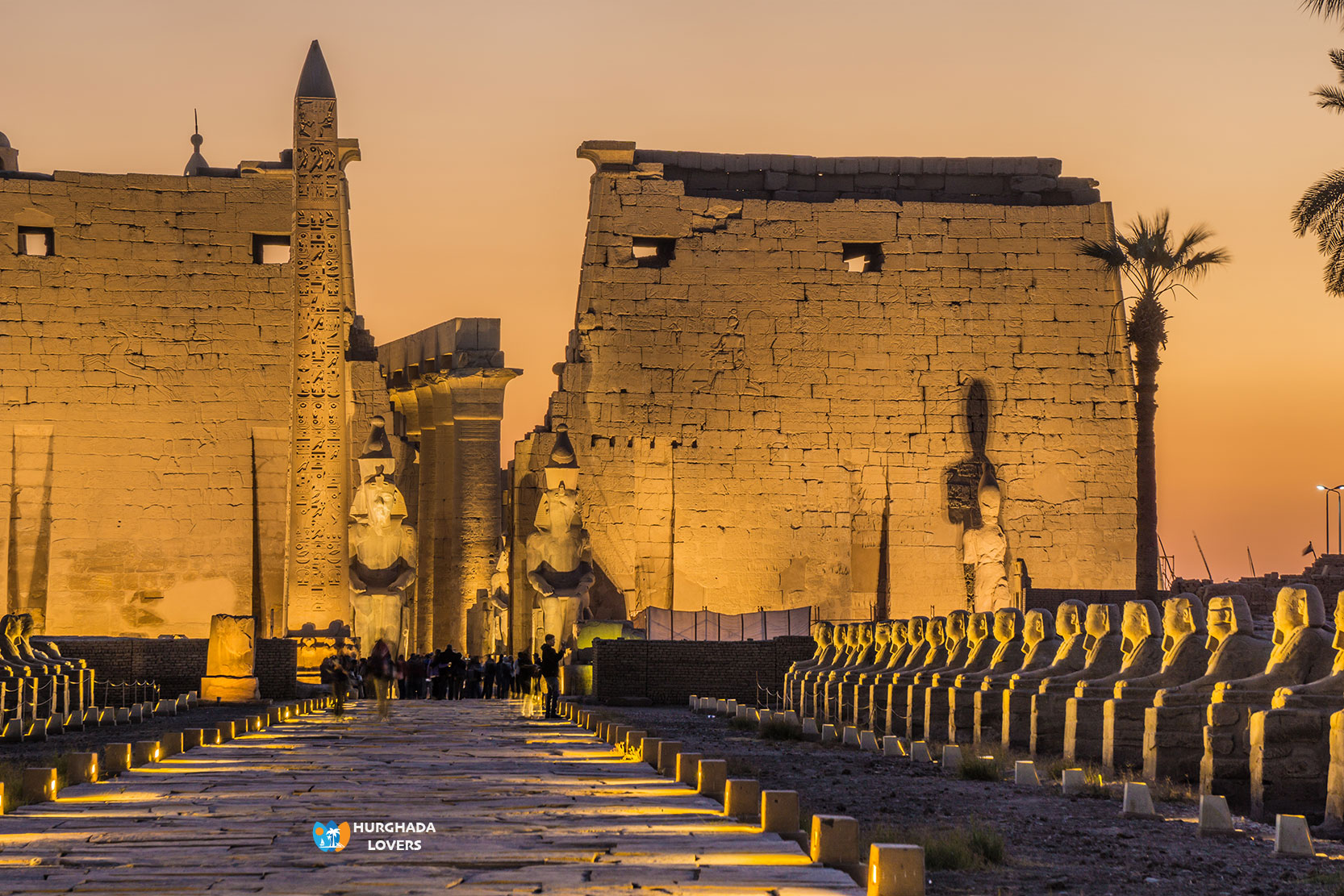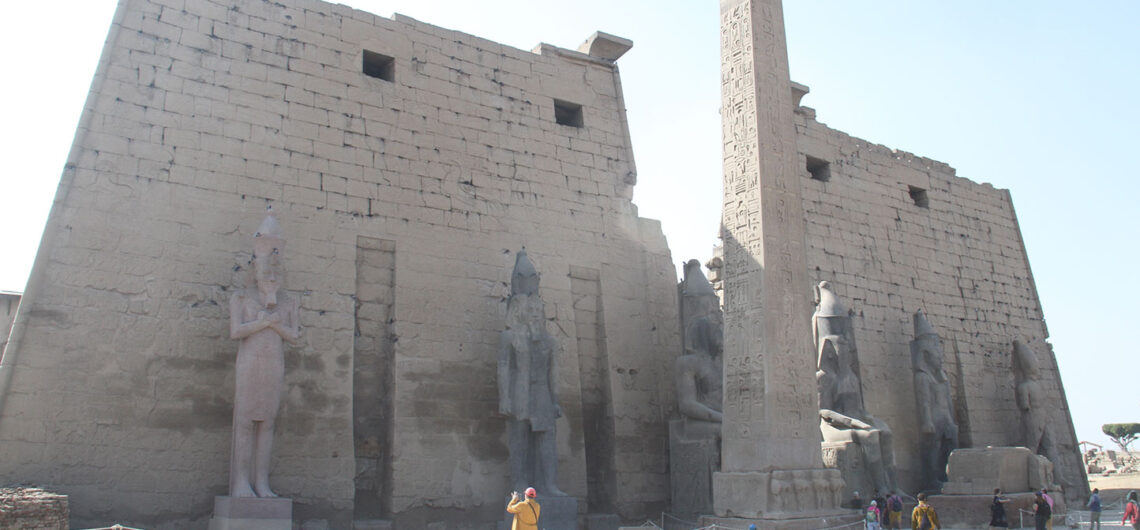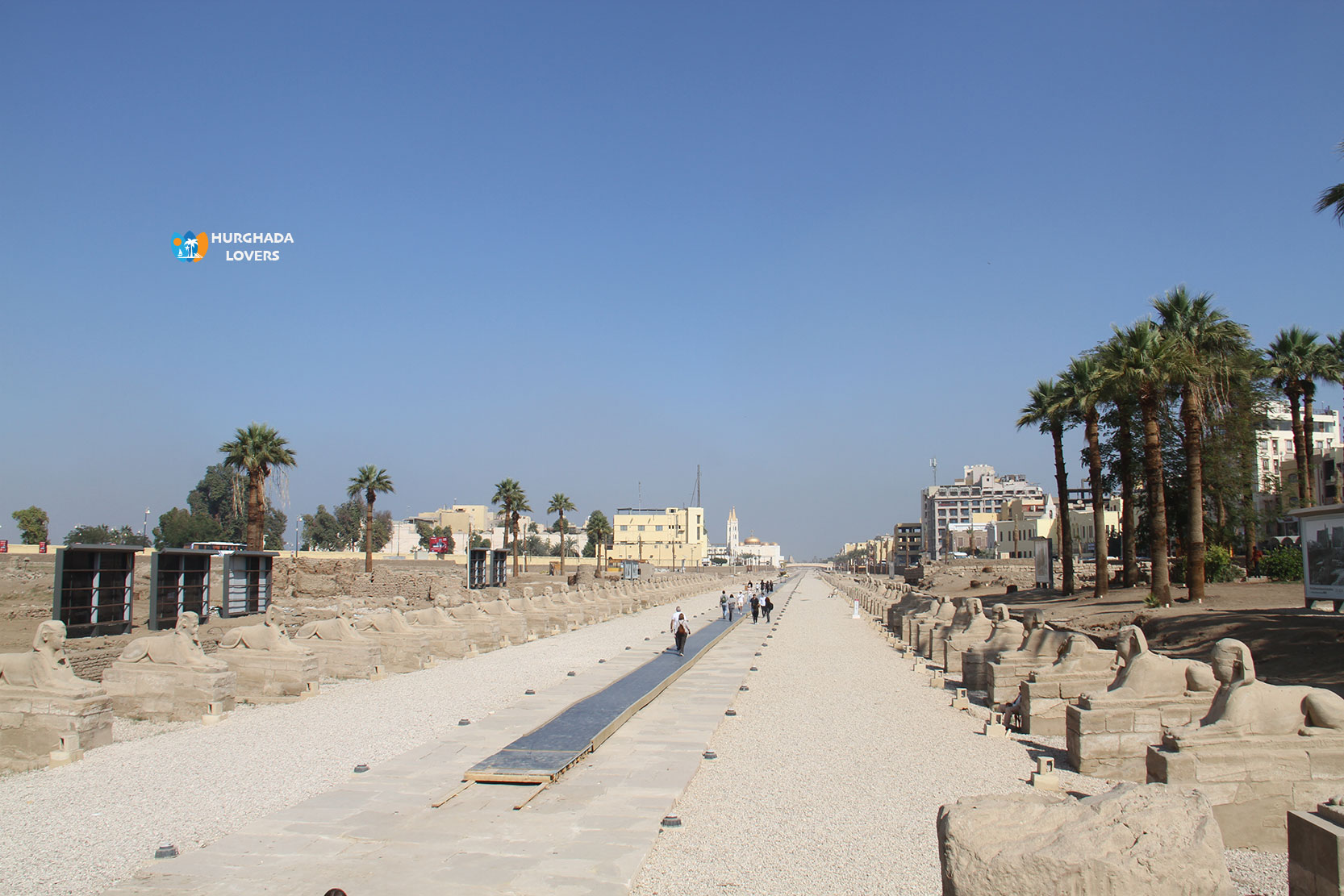Luxor Temple in Luxor, Egypt – Egyptian Temples
Discover the history of the Pharaonic civilization “Ancient Egypt History” and how the Ancient Egypt civilization began and ended by learning about the most important archaeological funerary Mortuary Temples in the tourist city of Luxor “Thebes”.
Luxor Temple includes the largest number of Egyptian Monuments, as it is considered one of the best Egypt Archaeological Sites that tells us the secrets of the lives and Egyptian Pharaohs kings.
Luxor Temple Facts
Who was responsible for building the Luxor Temple and to whom was it dedicated?
King Amenhotep III “Eighteenth Dynasty of Egypt” began building the Luxor Temple on the eastern bank of the Nile River in the city of Thebes (currently Luxor), and then King Ramses II of the Nineteenth Dynasty of Egypt in the The New Kingdom, one of the most famous Pharaohs, completed it.
It was dedicated to the worship of the God Amun, one of the most important ancient Egyptian deities – Ancient Egyptian gods and Goddesses, as in the Ancient Egyptian religion and the religious beliefs of the pharaohs..
Construction date: mid-1350-1400 BC.
Length: 803 feet.
Width: 181 feet.
Why was Luxor Temple built?
There are speculations from Egyptology who believe that King Amenhotep III of the Eighteenth Dynasty of Egypt built this temple to please the priests of Amun and the High Priest of Amun, and to bestow legitimacy on himself and obtain the Coronation of the Pharaohs by recording the story of his birth from the god Amun as in the stories of the myths of the pharaohs “Egyptian Mythology” and Ancient Egyptian Literature.
The wedding feast of the God Ra to his wife was celebrated once a year. The god’s procession moved from the Karnak Temple complex along the Nile to the Luxor Temple.
The entrance to the temple began with the pylon built by Ramses II, which had two huge statues representing him sitting, indicating the development of Sculpture in Ancient Egypt. It is considered the most famous of the Pharaonic feasts “Festivals in Ancient Egypt“.
The Luxor Temple is preceded by two Obelisks of the Pharaohs, one of which is still standing and the other adorns the Place de la Concorde in Paris, France.
This edifice is followed by the courtyard of Ramses II, surrounded on three sides by two rows of columns in the form of a bundle of Ancient Egyptian Papyrus plants supported by….
Two obelisks were built from pink granite (Ancient Egyptian Metallurgy), but one of the obelisks was moved to the Place de la Concorde in Paris, France, in 1836. The obelisk is 23 metres high and weighs 220 tons..
The second obelisk was built on the eastern side in front of the northern tower. The obelisk is 23 metres high on a strong base 2.5 metres high, and its weight reaches 257 tons..
The obelisk was painted with drawings of 4 monkeys playing and cheering the sun at sunrise, and inscriptions were made in Ancient Egyptian Language hieroglyphics with the name of the pharaoh Ramses II.
In addition, drawings were drawn on the top of the obelisk showing the ceremony of the king offering a sacrifice to the god Amun to tell us the secrets of ancient Egyptian decoration.
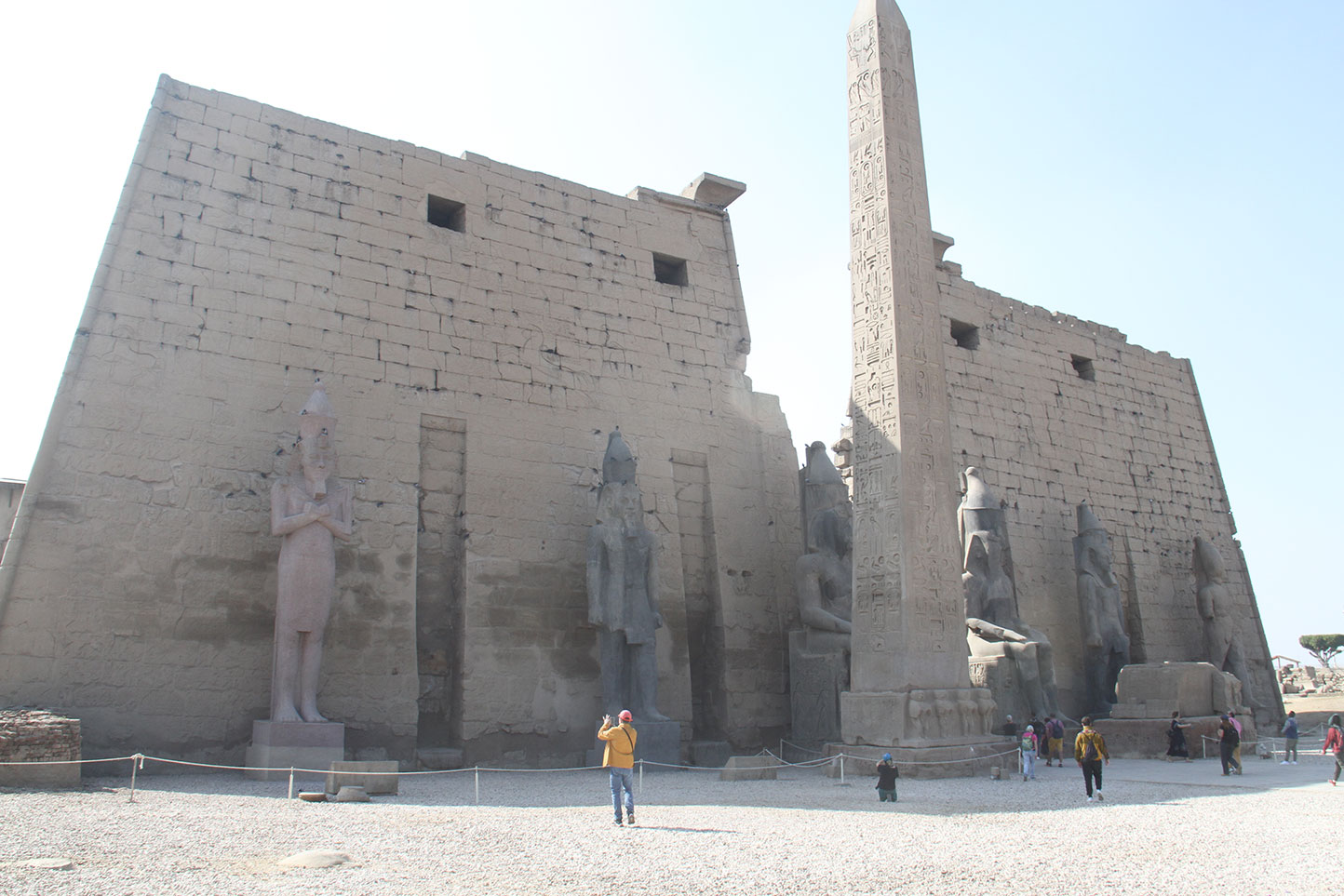
History of Luxor Temple for kids
- King Amenhotep III is considered the first to think of building the Luxor Temple in the city of Thebes in 1390-52 BC..
- King Tutankhamun (have Tomb of Tutankhamun | KV62 is in the Valley of the Kings) completed construction of parts of Luxor Temple in 1336-27 BC..
- King Horemheb (have Tomb of Horemheb | KV57 is the most famous Egyptian Tombs, in addition to the Tomb of Horemheb – Saqqara and The Speos Of Horemheb in Aswan) took care of developing the temple in 1323-1295 BC..
- King Ramses II (has Tomb of King Ramesses II | KV7 in the Valley of the Kings, the Temple of Abu Simbel in Aswan, and the Temple Ramses II in Sohag) added giant statues of himself and his wife, Queen Nefertari, the most famous queen of Pharaonic Egypt “Female Pharaohs“, in 1279-13 BC..
- The Greek-Macedonian emperor Alexander the Great built a granite mausoleum in 332-305 BC..
- The purpose of building the Luxor Temple is to worship the ancient Egyptian gods and beliefs..
- In the Coptic period of Egypt, the hypostyle hall was used as a church for Coptic worship and became part of the Coptic Egyptian Monuments & antiquities..
- The Sufi Sheikh Mosque, “Abu Al-Hajjaj Al-Aqsuri Mosque or Abu Al-Hajjaj Mosque,” was built next to the church and is still present today and has become part of the Islamic Egyptian Antiquities & monuments..
Secrets of Luxor Temple:
- Luxor Temple is considered one of the largest open-air museums in the world and history..
- The temple contains 3 religious places for three religions through the mosque (Islamic religion), the church (Coptic religion), and the ancient Egyptian Pharaonic religion..
- Sultan Muhammad Ali Pasha presented the Luxor Temple Obelisk to France in 1833 AD..
- The temple was built of sandstone..
- Temple width = 181 feet and length = 853 feet.
- Luxor Temple is connected to Karnak Temple through the Avenue of Sphinxes (the Sphinx) which is 3 km long..
- The Ipet Festival was held annually to transport the procession of the god Amun, his wife the God Mut, and their son the God Khonsu to visit the seat of the God Amunet in the Luxor Temple..
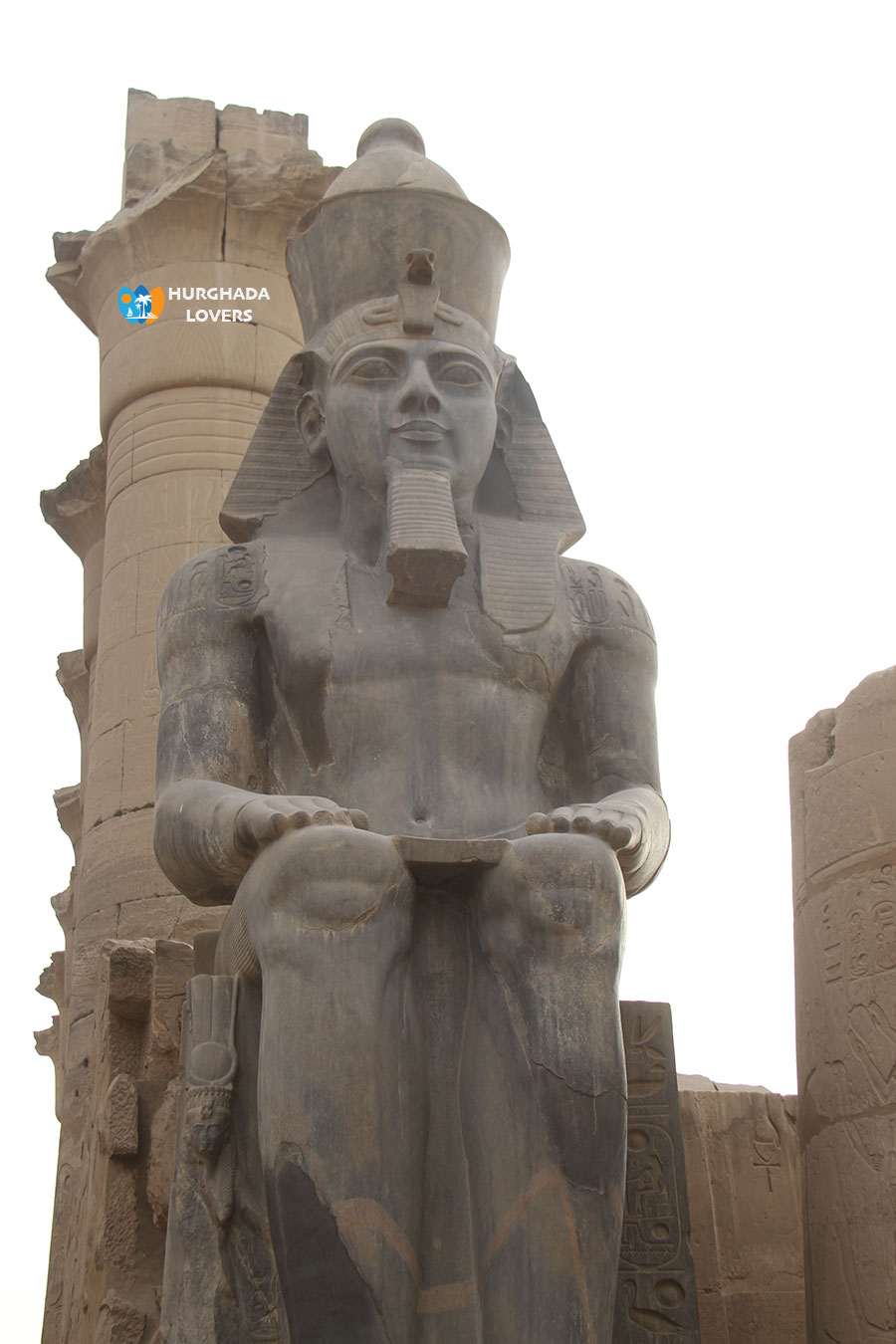
Luxor Temple Statues:
- Sphinx statues
- 6Statues of King Ramses II
- Religious beliefs and symbols in Luxor Temple:
- God Amun
- God is death
- The god Khonsu “the moon god”
- God Amunet
- God Ra
- God Montu
- The god Montu
- God Hathor
- God Nut
- Maat
- God Min
Luxor Temple Map from the Inside:
Avenue of Sphinxes “Street of Sphinxes” 3 km.
The first monument of King Ramses II
6 Colossal statue of King Ramses II
Opening of the court of King Ramses II
3 Shrines of Queen Hatshepsut and King Thutmose III
The second edifice
2 Colossal seated statue of Ramses II
Processional corridor of King Amenhotep III
Court of the Sun King Amenhotep III
Private hideout in Luxor Temple
vestibule
Alexander Chappell
Coronation room
Divine Birth Room
12 vertical hall
The Three Shrines of the Sacred Boats of Amun, Mut and Khonsu
Luxor Temple Surrounding Wall
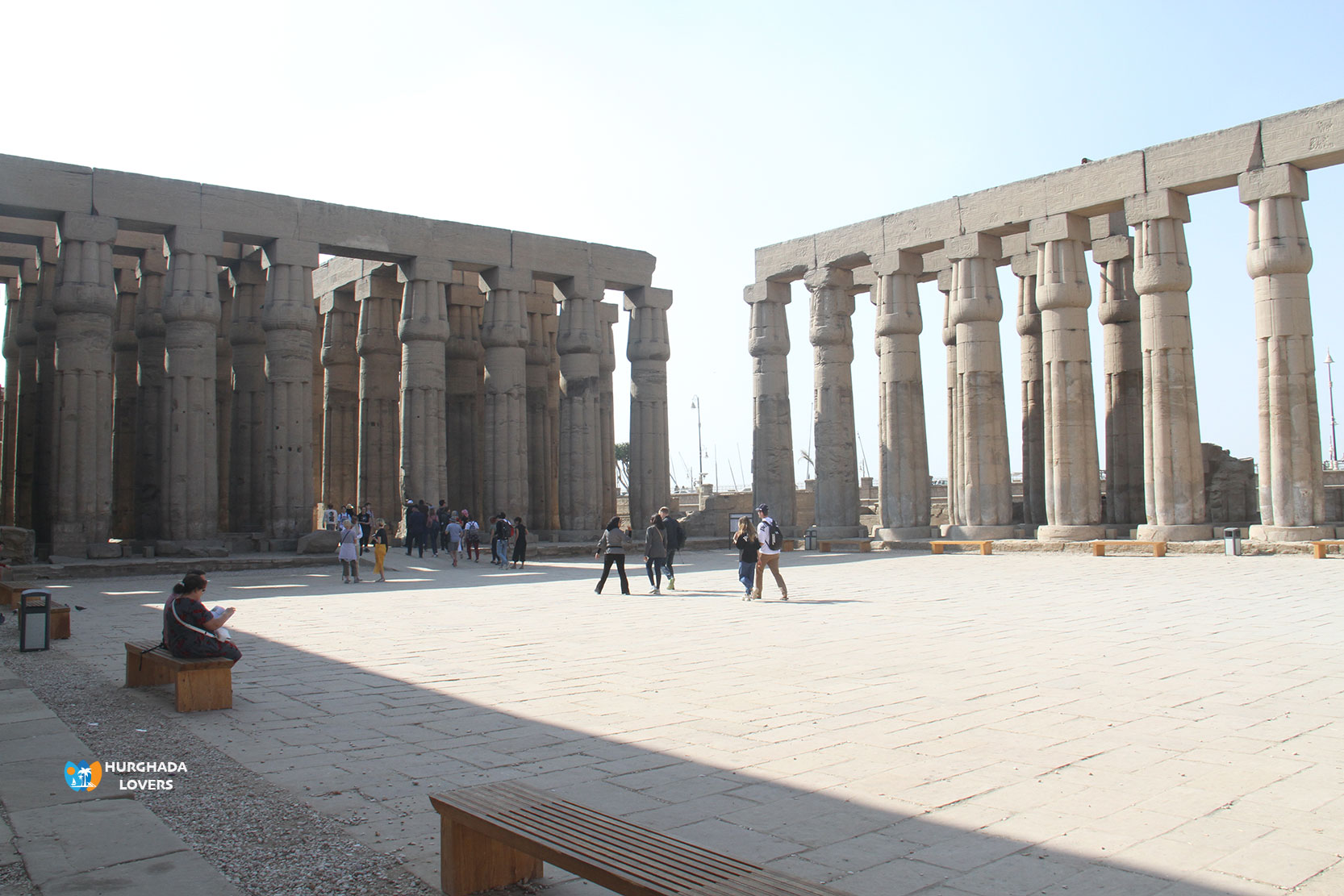
Architectural design of Luxor Temple:
Avenue of Sphinxes:
The road was completely restored during the rule of President Mohamed Abdel Fattah El-Sisi and the Avenue of Sphinxes was opened after more than one Sphinx statue was added to both sides of the road..
Egyptian Cartouche were discovered bearing the name of Queen Cleopatra VII, the last queen and king of the Ptolemaic Kingdom era, to tell us the secrets of her love with the Roman leader Mark Antony.“
You can visit Luxor Temple at night and walk on the Avenue of Sphinxes through the sound and light show..
Avenue of Sphinxes in Karnak Temple, Luxor, Egypt | Facts and history of the establishment of the most important monuments in the ancient Egyptian Pharaonic civilization, what does the Avenue of Sphinxes mean, how many Sphinxes are there on the road, what is the distance and how many kilometers and more.
The Avenue of Sphinxes is a road that connects both Luxor Temple and Karnak Temple. This road dates back approximately 3,500 years, is about 2.7 miles long and 250 feet wide, and the road was discovered in the area of Thebes, which is currently Luxor. Learn more about the road below..
Avenue of Sphinxes – The Road of Pharaonic Celebrations
A 2000-meter-long road connecting Karnak Temple and Luxor Temple..
The Opet Festival was held annually in the culture of ancient Egyptian civilization..
The celebration begins with the departure of royal boats from the Holy of Holies from the shrines of the gods Amun, Mut and Khonsu (the Theban Triad) in the Karnak Temple, surrounded by the temple priests and ancient Egyptians. The royal procession moves on foot until it reaches the headquarters of the priests of the god Amun in the Luxor Temple, then completes the journey across the Nile River to the Western Monastery, where the shrines of the Egyptian gods, religious beliefs and the tombs of the nobles are seen..
This celebration and Pharaonic rituals are still celebrated annually from the Abi Al-Hajjaj Al-Aqsuri Mosque, which was built in the Islamic era inside the Luxor Temple..
The beginning of the Avenue of Sphinxes was during the New Kingdom era and it was completed during the reign of King Nectanebo I, who dates back to the Thirtieth Dynasty of Egypt, the beginning of the Late Period.
The road was buried under layers of sand over the centuries, but was found in 1949 by Egyptian Egyptologists Dr. Zakaria Ghoneim..
The discovery of the road was part of the discovery of 8 statues near Luxor Temple..
After the discovery of this road, there were many other discoveries, including the discovery of 55 statues in 1961 AD, and before that, 17 statues were discovered in 1958 AD..
From 1984 to 2000, this road was designated as a walkway with excavators to complete the archaeological excavation operations..
The development projects for this road, which began in 2007 and stopped in 2011, were completed in 2017 and ended in 2021..
Description of the Avenue of Sphinxes
- The Avenue of Sphinxes is paved with a stone pavement, and there is a row on either side of the passageway of up to 1300 statues..
- The statues come in the form of a full ram or a ram’s head on a human body..
- Other statues include a human head on a lion’s body, which is why this road was named the Avenue of Sphinxes..
- This road is considered one of the most important historical roads and passages, as this passage witnessed the processions of the gods dating back to the era of the 18th Dynasty, which during the reign of Queen Hatshepsut had the Mortuary Temple of Hatshepsut in Deir El Bahari and the Tomb of Queen Hatshepsut | KV60 within the tombs of the Valley of the Kings..
- One of the celebrations that was also held on this road was the celebration of the Eid al-Abit, which is one of the most famous holidays that were held in ancient times..
- The number of original statues in this corridor is 1057, and they come in three forms and indicate the development of Architecture in ancient Egypt.
- The first figure is the body of a lion with the head of a ram and the statues are located approximately from the beginning of the Karnak Temple on an area of 1000 feet..
- While the second form is the full form of the ram, and the statues were built in a remote area during the reign of the Eighteenth Dynasty, and then it was moved to the Karnak area..
- The third figure is the Sphinx, which is approximately a mile from Luxor Temple..
Historical facts
The purpose of establishing the Avenue of Sphinxes is to be a road for the sacred processions of kings, such as ministers and high priests in the rule of ancient Egypt “Ancient Egyptian Government“, as well as the great pharaohs..
The coronation of kings in ancient times took place during the Ibt festival, which was held on the Avenue of Sphinxes..
King Amenhotep III (who has the Temple of Amenhotep III in El Kabin Aswan and the Mortuary Temple of Amenhotep III at Luxor) was the king who started the construction of the road during his reign, and he also started the construction of the Luxor Temple..
Although construction began during the reign of Amenhotep III, King Nectanebo I is considered the main founder of this road..
The statues on both sides of the road refer to the symbol of the God Khnum, the Egyptian god of fertility..
This road witnessed a large number of celebrations and processions, including the procession of the king and his followers of ministers and high priests..
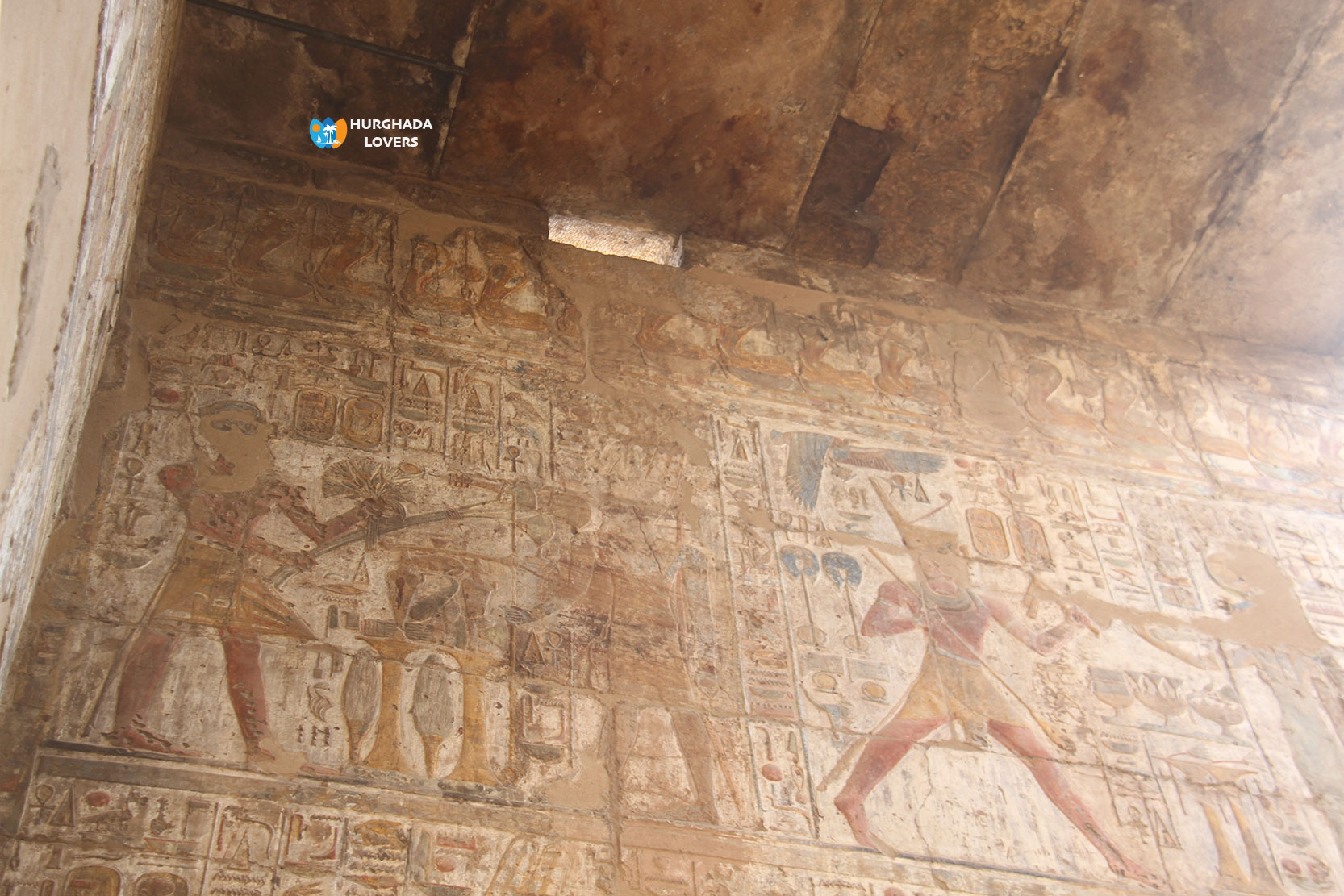
Renovation and opening
On November 25, 2021, the Avenue of Sphinxes was inaugurated in the presence of Egyptian President Abdel Fattah El-Sisi..
This opening caused a huge stir and surprised not only the Egyptians..
The restoration process took nearly 7 centuries..
The parade was joined by a team of actors in Pharaonic costumes as in Clothing in ancient Egypt, lighting effects, dancers, as well as boats on the Nile and horse-drawn carriages..
In addition to the role of the orchestra that played a historical hymn as in the Music in Ancient Egypt, at the beginning of the celebration there were 3 sacred boats designed in the Pharaonic style..
The boats were designed to symbolize the sacred Theban triad of Amun, Khonsu and Mut..
Such rituals were performed in ancient times on the harvest festival and the king’s enthronement festival.
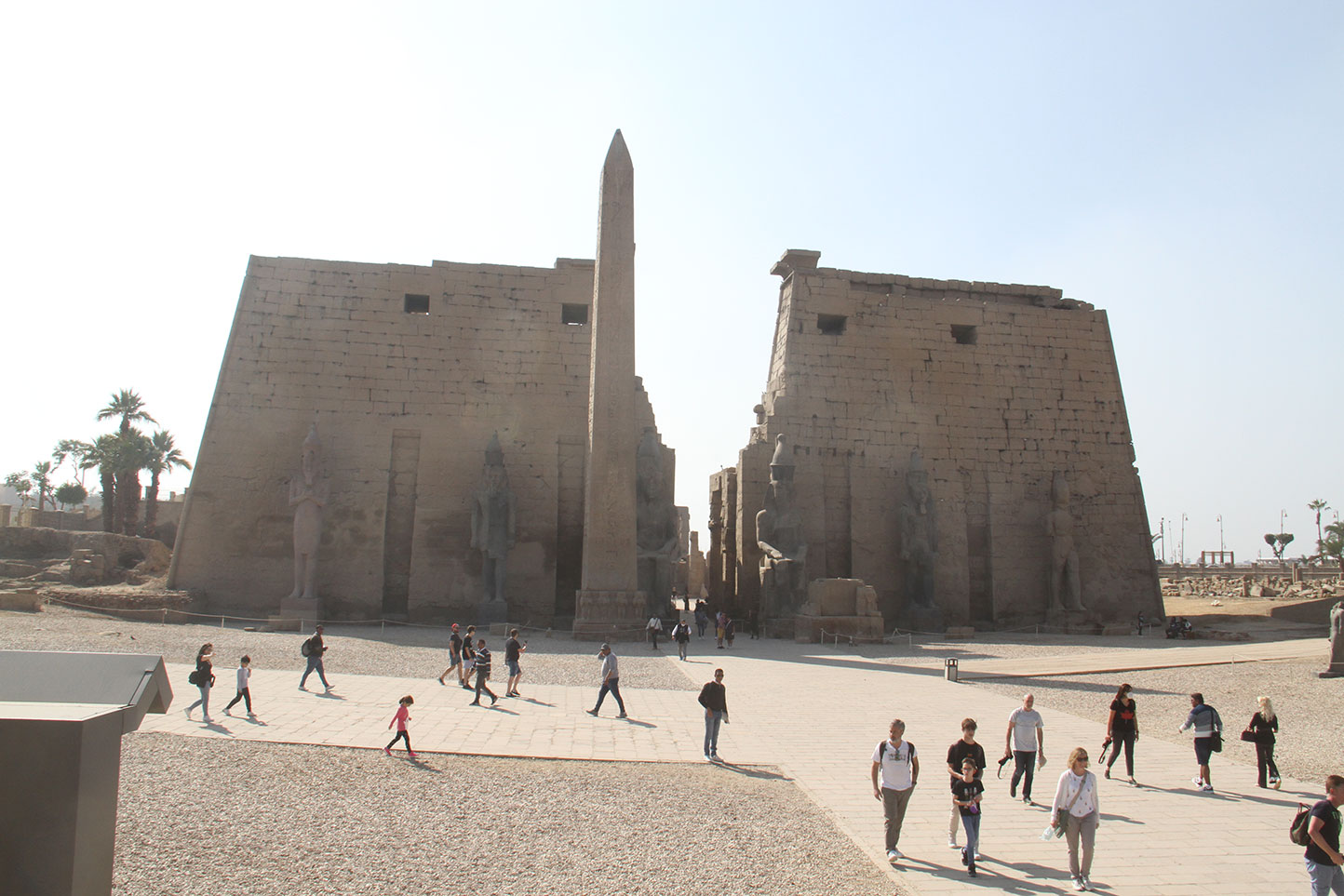
Stages of development and opening of the Avenue of Sphinxes:
The Egyptian government and the Egyptian Ministry of Tourism and Antiquities have taken a bold decision to develop Luxor Temple by removing all illegal residential buildings, gatherings and shops located on both sides of the Avenue of Sphinxes, to re-excavate and dig in it and bring it back to life as it is now. It was inaugurated by President Abdel Fattah El-Sisi..
There were objections from some Egyptian journalists such as the writer Samir Gharib and a French writer living in Luxor, in addition to the Chicago House Institute, and the intervention of the UNESCO World Organization to know the details of this development and the decision..
The residents were compensated with alternative housing or received financial sums in exchange for leaving their homes and shops, under the leadership of Major General Samir Farag, the Egyptian government, and the workers of the Supreme Council of Antiquities in Luxor..
The Sphinx statues were excavated and dug under the ground for long distances, until more than 50% of the statues were discovered and completely restored by a scientific team and Egyptian Egyptologists with high efficiency..
During the excavation, a stone tablet was discovered dedicated to the high priest of King Setnakhte, “Priest Pak-en-Khonsu,” one of the kings of the Twentieth Egyptian Dynasty of the Pharaonic The Ramesside Period era..
Obelisks of King Ramses II:
There is one obelisk, 23 metres high, with hieroglyphic texts written on it, depicting King Ramses II and the god Amun-Ra, in addition to statues of baboons at the bottom of the obelisk, raising their hands to greet the sunrise every day in front of Luxor Temple..
The first monument:
The monument consists of two towers, 24 metres high and 65 metres wide..
Reliefs of the battle between King Ramses II and the Hittites, “Battle of Kadesh,” and reliefs of King Ramses II defeating and defeating the enemies..
The Great Court of Ramses II:
Area = 54 meters and length 51 meters.
The first part on the left side, we find Al-Hajjaj Mosque..
A three-bark shrine built by Queen Hatshepsut and King Thutmose III. “He has the Temple of Thutmose III at Deir el-Bahari and the tomb of King Thutmose III within the tombs of the Valley of the Kings.” Then 4 columns..
A large courtyard containing 74 columns with rose-leaf capitals and statues of King Ramses II with the white, red and double crowns to indicate the unification of the regions of Upper and Lower Egypt as in the Geography of ancient Egypt.
The second edifice:
It contains two statues of King Ramses II made of black granite, engraved on the base with the names of the king and the sign of Sima-Tawy..
Processional corridor of King Amenhotep III:
The portico consists of 14 columns with open papyrus capitals, each 19 metres high. King Tutankhamun, King Horemheb and King Ay developed and restored the columns during their reign..
Court of the Sun King Amenhotep III:
The Great Hypostyle Hall of Luxor Temple measures about 45 metres by 46 metres and contains 60 columns with rosette capitals on 3 double sides.
Imperial worship chapel:
It was built inside the Luxor Temple in the Roman era in the third century AD and depicts inscriptions and scenes of the Imperator Diocletian and his three companions and Maximilian with their Caesars Constantius Chlorus and Galerius.
Two rooms for the god Mut and the god Khonsu.
The second vestibule or waiting room:
A room containing 4 columns and was used to offer sacrifices to the god Amun..
It contains wall engravings of King Amenhotep III offering sacrifices to the god Amun..
Barki shrine of Amun:
Wall inscriptions of Alexander the Great or King Amenhotep in front of the god Amun.
Coronation room:
Wall inscriptions of King Amenhotep III as a symbol of the sun and during the coronation of the throne of ancient Egypt.
Delivery room:
Wall inscriptions of King Amenhotep III “The Divine Nativity Scene””
Alexander Barke’s Tomb of Amun:
The hall contains 12 columns..
Holy of Holies:
A room was built during the reign of King Amenhotep III and contains 3 small rooms for offerings to the Luxor triad of Amun, Mut and Khonsu..
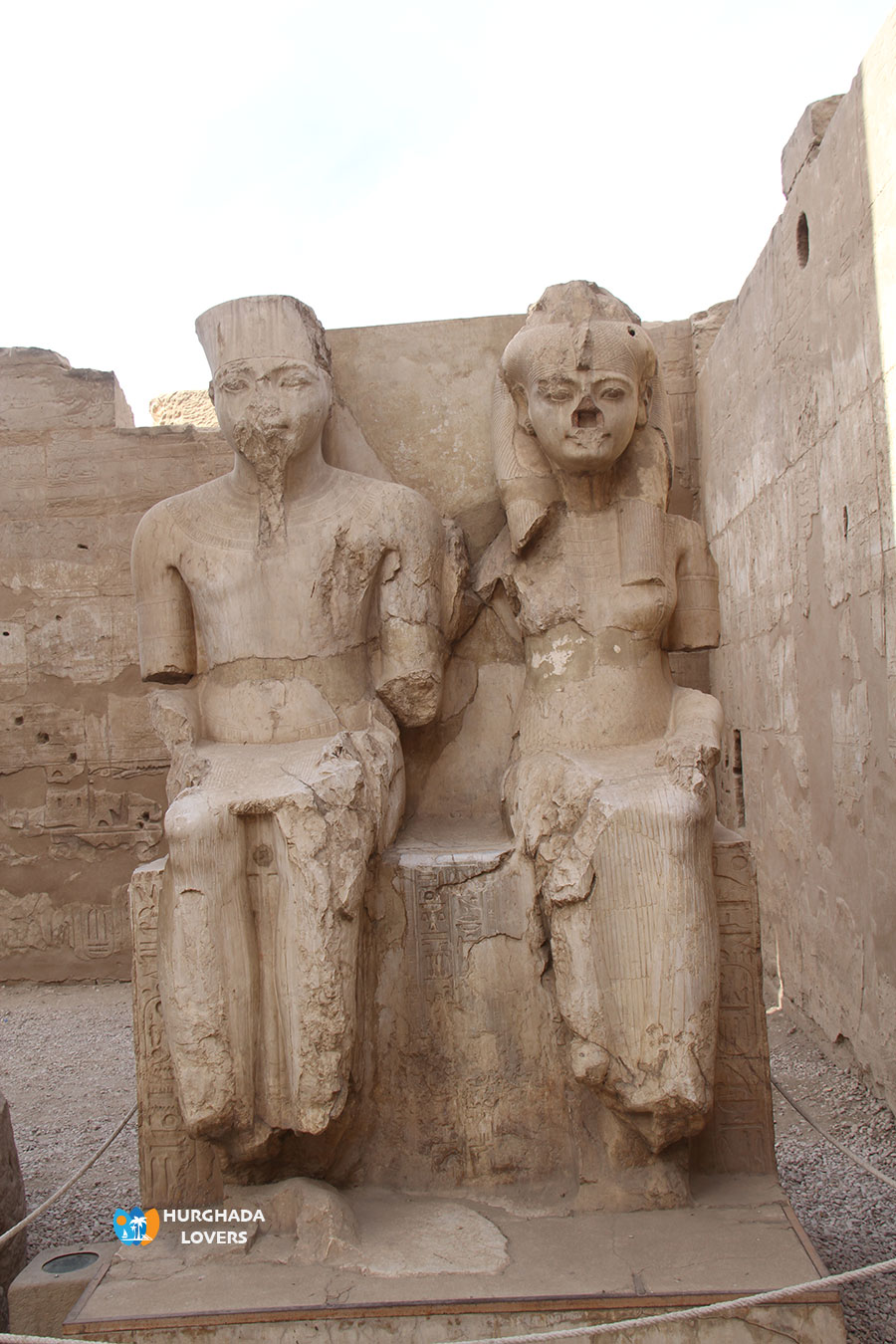
Luxor Temple from the inside:
The temple is 853 feet long and 181 feet wide, and was built between two periods between the last years of the Eighteenth Dynasty and the first half of the Nineteenth Dynasty, where the Luxor Temple was built in the middle of the 1350s and 1400s BC..
The temple was built to worship Amun-Ra, his wife Mut, and their son, Khonsu. King Tutankhamun developed the temple and completed the construction by completing the drawing of Pharaonic drawings and inscriptions on the columns and walls of the temple..
The triple cabin was rebuilt in the era of the Pharaoh Ramses II, as it had been destroyed for long periods and belonged to Queen Hatshepsut, one of the most famous queens of Pharaonic Egypt, and King Thutmose III of the 18th Dynasty..
It was called in ancient Egyptian under the name “Ipet Res Ai Yt” which means the southern harem or in other linguistic terms the southern chamber where Mut, the wife of Amun, resided. The temple was dedicated only to the trinity of the city of Thebes, which are “Amun – Mut – Khonsu”.“
The Pharaohs were interested in building the Luxor Temple with the strongest stones, namely King Amenhotep III and Ramses II..
King Amenhotep III built a very large hall containing 64 columns and another hall containing 32 columns, both of which were called the “Court of the Sun” because they were open from all directions to view the sun and the sky, to tell us the secrets of sculpture in ancient Egypt..
King Ramses II took care of the Great Temple of Luxor by building a private courtyard in front of the temple, which contains covered corridors..
Luxor Temple includes distinctive architectural designs as it contains (Hall 14, Alexander the Great’s Chamber, the Divine Birth Chamber for the birth of King Amenhotep III) and also includes Pharaonic papyrus columns with a unique architectural heritage to tell us the secrets of architecture in ancient Egypt..
One of the most important occasions of the Great Luxor Temple is the “Opet Festival”, which tells the story of the journey that King Amun’s procession takes from Karnak Temple to Luxor every year..
There was a road called the Avenue of Sphinxes linking Karnak and Luxor, in addition to two obelisks. One of the obelisks was transferred to the city of Concorde in Paris, France, and it still exists today..
The Pharaonic engineer Amenhotep, son of Hapu, is considered to have supervised the engineering and architectural construction of the Great Luxor Temple..
Drawings and scenes on the columns of Luxor Temple
There are drawings and scenes on the walls behind the columns, where the king is depicted in the presence of the gods. There are also 6 statues on the western side of the courtyard separating the columns, in addition to drawings of the religious procession of a king, to reveal to us the secrets of the art of drawing in ancient Egypt..
There are drawings on the walls of the temple facade that express the immortal Battle of Kadesh that the Pharaoh led during his reign, in addition to the wars of King Ramses II along the walls of the Arab wall of the temple directly behind the monument to represent his Asian conflict and wars..
One of the distinctive features of the construction of Luxor Temple is the “temple axis”, where engineers built temples on the east bank of the Nile River in the same direction as the west-east axis, while temples were built on the west bank in the direction of the east-west axis..
But strangely, the temple was built in a north-south direction with the same direction as the Karnak Temple with the direction of the Avenue of Sphinxes known as the “Avenue of the Sphinxes.”“
But during the reign of the Pharaoh Ramses II, he changed the path and axis of all the columns and temples..
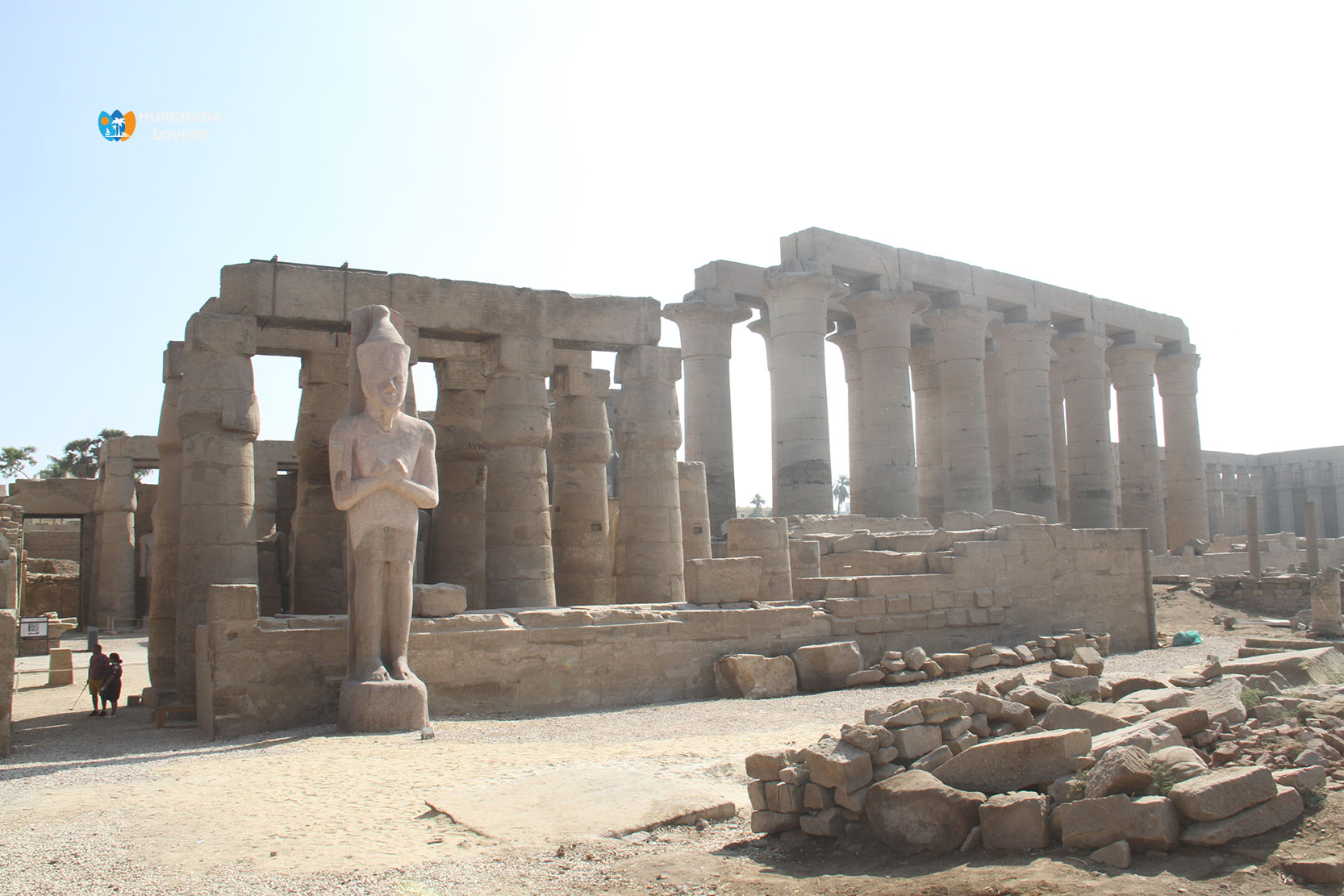
What is the importance of Luxor Temple?
In order to confirm to his people and opponents his pharaonic family lineage to the god Amun and that he was his descendant and had the first right to the throne of Egypt, the Pharaoh Amenhotep III created a birth room and recorded his birth on the wall and the walls of the room entirely..
There is another opinion from researchers and Egyptologists that the reason for King Amenhotep III building the Luxor Temple is to please the priests of the god Amun, so that he could become a king on the throne of ancient Egypt as a legitimate king, as he drew special drawings of the god Amun describing him as the god of fertility and called them “Amun-Ra-Ka-Mut-Fi” or “Amun-Ra-Thor-Ame” to tell us the secrets of the pharaonic political pyramid..
You should know that in order to assume the throne of Egypt during the era of the Pharaohs, one had to be the legitimate son of a Pharaoh or the pure lineage of a princess or marry the eldest daughter of the king.
However, all of the conditions did not apply to King Amenhotep III, as his mother was not Egyptian and his wife was not from the ruling royal family..
The entrance to Luxor Temple is considered one of the most beautiful unique architectural designs, as it includes a first tower that reaches a height of 24 meters.
Drawings were drawn of the victories of King Ramses II in many battles, such as the Battle of Kadesh and the victories of the Twenty-fifth Dynasty of Egypt, the beginning of the rule of king Piye of the ancient Nubia dynasty, to tell us the secrets of the Black Pharaohs and art in ancient Egypt..
The Pharaoh Ramses II’s monument
The monument is 24 metres high and 65 metres wide and stands in the middle of the entrance to Luxor Temple as a huge gate with a unique design..
The right western side of Luxor Temple
You will find drawings on the wall of King Ramses II and the military advisors in the far north, then we head to the middle area and find drawings of the military battles of King Ramses II against the enemies, then on the last right side we find drawings of the king riding his pharaonic war chariot during the battle to tell us the secrets of the army in ancient Egypt..
Left eastern side of Luxor Temple
King Ramses II was drawn on the walls riding his pharaonic war chariot while shooting arrows at the Hittites, in addition to drawings of the dead and wounded in the war. In addition, some soldiers were described fleeing in fear of the king, with a depiction of Prince Kadesh describing him as afraid of the king while riding the war chariot..
The battle is fully described in hieroglyphics on the lower part of the monument, in addition to 4 gaps between the columns for placing the flagpoles and 4 gaps above the monument for placing the flagpoles..
Six large statues of King Ramses II were built (four standing statues and two statues on each side). With the passage of time, erosion and climate, only one statue remains, currently located on the far right of the entrance..
There are also two huge statues on either side of the entrance of King Ramses II sitting on the throne, in addition to drawings and engravings on both sides of the throne showing the union of the two countries in Egypt..
There is a small statue of Queen Nefertari on the side of the throne next to King Ramses II and another statue on the right side in addition to a base below the statues engraved with drawings of prisoners and names, where the height of each statue reaches 14 meters..
Inscriptions and drawings of King Ramses II’s relationship with the gods were drawn on both sides of the entrance from outside the Luxor Temple, such as a drawing of the sacred triad of Thebes, the god Nut, and King Shyaka with the gods Amun, Mont, Montu, and Hathor.
In addition, Pharaonic drawings were drawn on the left wing of the edifice of King Ramses II with his wife during the celebration of the festival of the god Min, with the presence of drawings of priests and the god, as was believed in ancient times in the era of the Pharaohs.

First Courtyard at Luxor Temple
King Ramses II built a very large courtyard, 57 metres long and 51 metres wide, in the direction of Karnak Temple, where he placed a roof on both sides of the courtyard with two rows of columns..
The columns are designed from 74 columns in the shape of the Pharaonic papyrus plant, and the columns end with crowns of papyrus buds known in the ancient Pharaonic era..
King Thutmose III’s chambers
The shrines are located on the northwest side of the courtyard of King Ramses II and are dedicated to Queen Hatshepsut and the Pharaoh Thutmose III.
In addition, you will see 4 columns for the god Amun-Ra in the middle shrine, the Arab for the sacred boat of the god Mut’s wife, and the eastern for the son of the god Khonsu, who was called the moon god..
Pharaonic drawings and engravings were drawn on the shrines, representing the offering of sacrifices to the sacred boat of the pharaohs, which belonged to the goddess..
14-cylinder courtyard in Luxor Temple
It is considered the private entrance of King Amenhotep III. The height of the monument is 24 meters and its width is 65 meters. The entrance is surrounded by a huge gate with gaps to place the masts on, in addition to 6 statues of Ramses II, two obelisks, and a huge base with 4 monkeys on it..
Temple of Amenhotep III:
The shrine of the divine trinity (Amun, Mut, Khonsu) who are (the greatest god, his wife, their son the moon god). The Luxor Temple is considered the pride of Egyptian architecture during the Eighteenth Dynasty and is generally called (Luxor Temple). The temple is essentially rectangular with its parts located on a single axis, surrounded by columns with an open or sleeved papyrus capital and consists of the following parts::
The entrance has two high walls with a slight slope..
The large open courtyard surrounded by a covered portico supported by columns and is reserved for the public..
The way to the lobby.
The large, roofed hall, surrounded by tall columns, is reserved for the priests and is poorly lit..
The Holy of Holies (the room of the god Amun) at the back of the temple where the statue of the god is located..
Chambers of the gods (wife, son, and perhaps others)).
The huge wall of mud.
The monument in front of the outer wall where two seated statues stand + two standing statues + two obelisks.
The road leading to the temple, lined on both sides with statues of lions’ heads and rams..
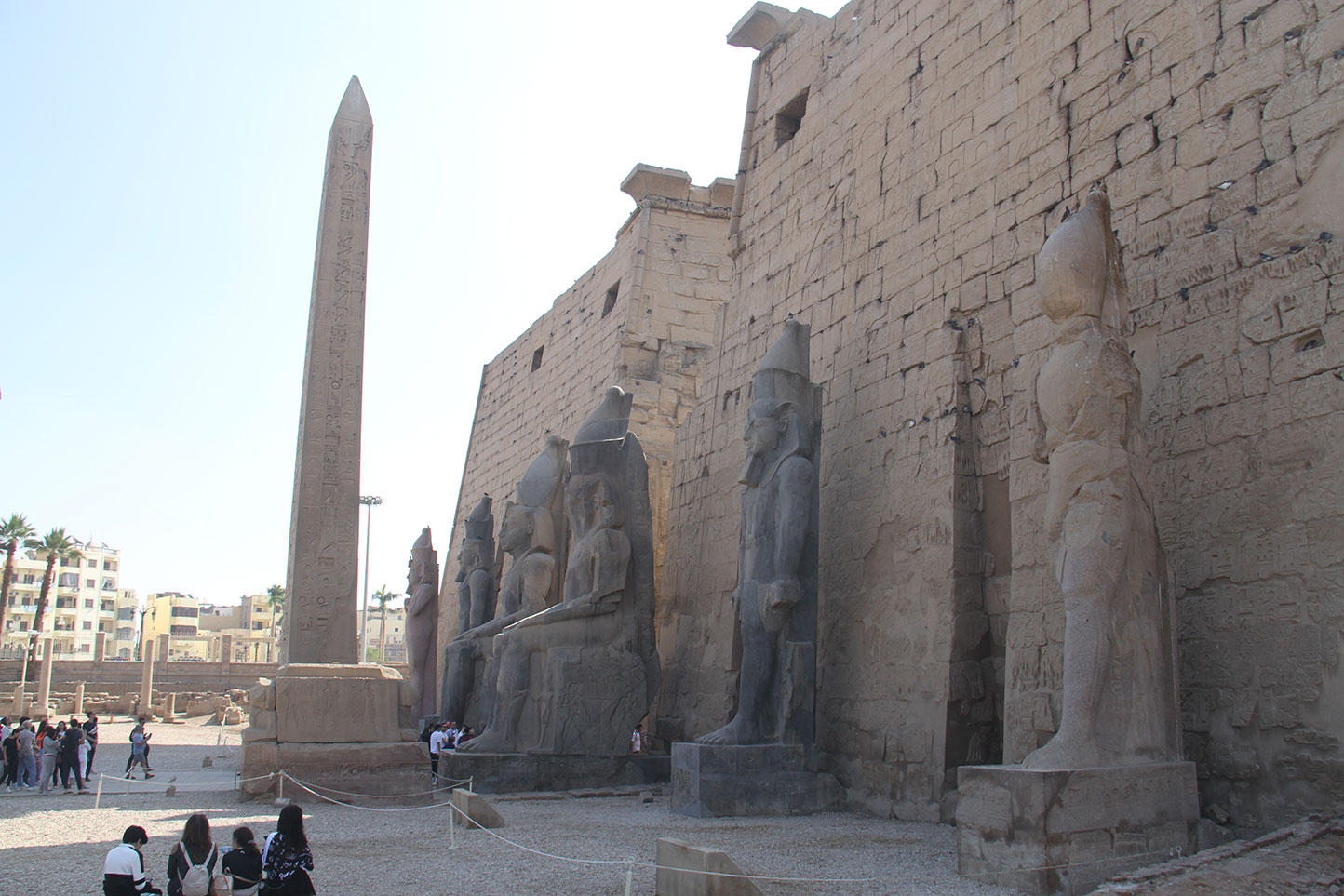
About King Amenhotep III:
He took the solar name Neb-Maat-Re, “Maat, Lord of Truth,” which was written several times on cuneiform tablets at Tell el-Amarna in Minya..
The king’s mother is called Mutem Uya, “Mut in the Solar Boat” in the reliefs at Luxor Temple and she resembles her husband, with whom Amun repeated what he had done before with Queen Ahmose Nefertar, wife of King Ahmose I. We know little about this princess..
The British Museum holds a black granite model of a solar boat, but the statue of the queen is broken in the middle.
A statue found in the Temple of Dendera in Qena is no longer sufficient to attribute it to the queen. We warn our readers against the view that she is the Medean princess, daughter of King Artama, whom King Thutmose IV married and eventually joined his harem..
In the middle of the Eighteenth Dynasty, the pharaohs took a wife from the neighboring country, but it was never said that Amun, the mother of Uya, who came from Mitanni, took an Egyptian name upon her arrival in Thebes.
In short, King Amenhotep III was the son of King Thutmose IV and the royal wife Mut, the mother of Uya, whose name and some of her titles we only know..
The Egyptian Museum (Museums in Cairo) in Tahrir Square preserves an amazing head of King Amenhotep III.
The sculptor gave the king the characteristic features of an Egyptian from the south: a long nose, Mongolian eyes, and a slightly curved chin. The two Sphinxes in Leningrad are very similar to him, but the expression is more eloquent.
Today, we find such features in Thebes, and the sculptor who makes them models for his works is very close to King Amenhotep III..
Experts attribute to Manetho 0.5 or sometimes 34 years, the latter number being closer to the truth, and the year 37 began and he had died..

Address:
The West Bank Eastern, Luxor, Egypt.
Opening Hours:
Open daily from 06:00 AM to 08:00 PM
Temple ticket priceLuxor early November 2024:
Adults = 500 Egyptian pound
Student/Children 5-11 years = 250 Egyptian Pound.
Discover the history of the ancient Egyptian civilization, the Pharaohs, the facts of the Pharaonic antiquities, and the map of Egyptian antiquities through our website to learn about the secrets of the Pharaohs and how their lives were, in addition to the Egyptian Islamic and Coptic antiquities in all the cities and governorates of Egypt..
Discover the history of ancient Egypt and the establishment of the most important Pharaonic monuments and ancient funerary temples from the ancient Egyptian Pharaonic civilization.
What are the secrets of building the temple and what it contains of drawings and scenes on the temple columns, entrance ticket prices, working hours, and more temples of the Pharaonic civilization..
Details of Luxor Temple from the inside and the most important landmarks of ancient Egyptian civilization and the antiquities of the East Bank in Luxor.
Information and details about the most important antiquities and archaeological landmarks of the Great Luxor Temple that you did not know before, to start your historical journey to the Pharaonic era and visit the tourist attractions in Luxor and learn about the tourist attractions in archaeological Egypt
Note: Facts and secrets of the history will be added soon…
Hurghada Excursions Lovers, Best Travel Agency in Hurghada to provide daily tours to visit the Tourist attractions of Luxor by Hurghada to Luxor Tours and Hurghada to Pyramids Trips. Book online when you come to Hurghada, El Gouna, Sahl Hashish, Makadi Bay, Soma Bay, Egypt Tours Packages.
